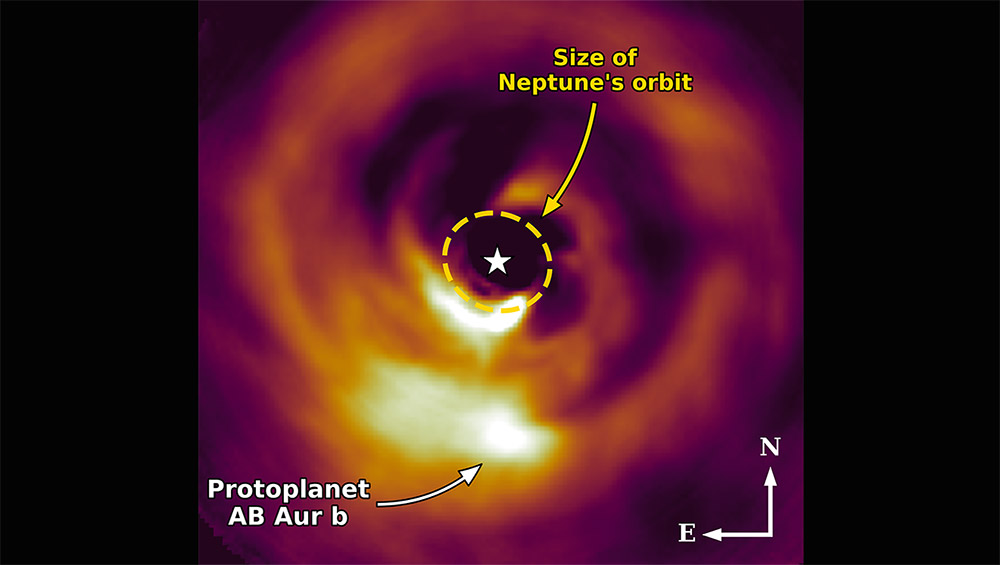Meaningful point of light: Astronomical observations show for the first time that gas-massive planets can also form at great distances from their star – through the direct collapse of gas. Evidence for this is provided by a young gaseous planet around the star AB Aurigae, which is 520 light-years away and orbits its star at a distance of a good 90 astronomical units. Therefore, it is too far from being created by the classic accumulation of dust and bits, as the researchers report in the journal Nature Astronomy.
Earth and most of the other planets in the solar system were formed by accretion – the slow accumulation of dust and large masses. So far, however, it has been debated whether this mechanism planet formation It also applies to gaseous planets in farther orbits, such as Jupiter or Saturn. Because at this distance from the Sun, there was not enough dust as a building material, it could also have formed through a local collapse of gases – similar to the formation of stars. So far, however, there is no evidence for this.
also with each other outer planets Astronomers puzzle over how they formed. Because these young gaseous planets sometimes orbit about 50 to 200 AU away from their star, and thus in a fairly thin, material-poor region of their protoplanetary disk. Because the protoplanets shown earlier are like PDS 70 b But since they were several million years old, astronomers cannot rule out the possibility that they formed again inward and only then migrated outward.
Young, heavy and far from the star
Astronomers led by Thayne Currie of the National Astronomical Observatory in Japan may have discovered clearer evidence of an in situ formation of a distant orbiting gas giant. Using the Subaru Telescope in Hawaii and the Hubble Space Telescope, they took a closer look at the young stars AB Aurigae, 520 light-years away. In this case, telescopes have previously found evidence of at least one planetary embryo.
New records confirm this. They show a distinct bright spot of light about 93 astronomical units away from its star – orbiting about three times as far as Neptune in our solar system. The protoplanet, nicknamed AB Aurigae b, weighs about nine times the mass of Jupiter and is three times the size of Jupiter. From the spectral properties of the point of light, the team also concluded that it must have been a protoplanet around a million years old. “It thus represents an earlier stage in planetary formation than the PDS-70 system,” the astronomers say.
Properties support formation by gas breakdown
Also interesting: the protoplanet is close to one of the spiral arms that pierce the disk of gas and dust around the young star. “AB Aurigae b appears as a distinct mass surrounding these arms,” the team said. “Thus, the features of this protoplanet are very similar to models of planet formation through gas instability.” According to these models, the local collapse of gas in protoplanetary disks could lead to such a chiral perturbation.
This is supported by another observation by astronomers: telescopic images show two points of light far from each other, which could have come from other planetary embryos. At a distance of 430 and 580 astronomical units, these minor planets are far from their star. So it may also not have been formed by classical accretion.
A new perspective on ‘our’ gas giants?
“This evidence of at least one protoplanet at a great distance from AB Aurigae has important implications for our understanding of where planets formed,” Curie and colleagues stated. “AB Aurigae b could give us the first direct evidence that Jupiter-like planets can form from gas instability.”
If confirmed, it will also shed new light on the composition of the gas giants in our solar system. For Jupiter and Saturn, too, there is disagreement over whether they were formed by local gas breakdown rather than accretion. (Natural Astronomy, 2022; doi: 10.1038/s41550-022-01634-x)
Source: Nature Astronomy

“Social media evangelist. Baconaholic. Devoted reader. Twitter scholar. Avid coffee trailblazer.”








More Stories
Longest jets in the universe discovered – giant particle streams as long as 140 Milky Way galaxies in a row
New method reveals 307 supernova remnants
Snapchat is upping the ante on augmented reality glasses